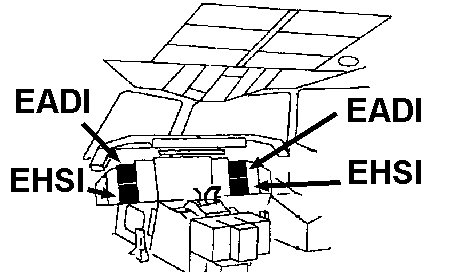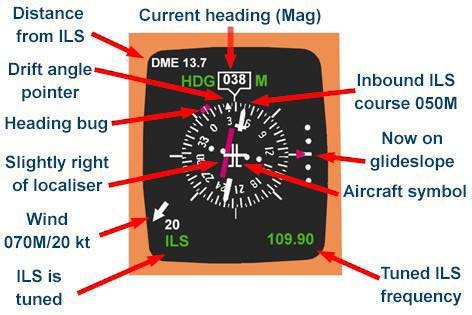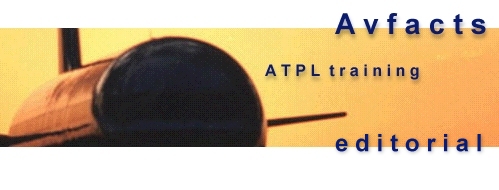-
They are more reliable.
-
They allow the crew to
display selected information, thereby avoiding screen “CLUTTER”
and information overload
-
CRT units incorporate a
light sensitive device that will automatically adjust display
brightness to compensate for varying light levels, such as happens
when flying in and out of cloud. The EFIS can display more information
than can the conventional ADI/HSI, increasing the crews situational
awareness of their vertical and horizontal path in space.
-
CRT units use various
colours to better inform crews of the modes the aircraft is currently
flying in, and which waypoint the aircraft is currently flying toward
(ie: the “ACTIVE” waypoint).
-
The EFIS reduces the
amount of scanning required by the crew. (eg: All information required
to fly an ILS can be found on the EADI screen, with no need to cross
scan to other instruments).

FULL ILS mode
There are six different EHSI
modes which can be set by the crew using the EHSI control panel. In this
mini editorial we will be looking at the “FULL ILS” mode.
This mode provides the same
360 degree compass presentation as does a conventional VOR/ILS instrument,
and it is oriented HEADING UP.
The “FULL ILS” and “FULL
VOR” modes are sometimes referred to as “ROSE MODE”.
Orientation
Like the EXPANDED ILS it is oriented
magnetic HEADING UP. Weather radar returns CANNOT be
displayed in FULL ILS mode, but can in “EXPANDED ILS” mode.
Aircraft Symbol
Like the conventional VOR/ILS
instrument, the aircraft symbol is shown in the centre of the compass
rose. It is displayed in white.

ILS selection/distance
The fact that ILS is feeding
tracking information to the screen is displayed in green at the bottom
left-hand corner of the screen, whilst the distance to that station is in
the upper left corner. The ILS frequency is displayed in green in the
bottom right-hand corner. Inbound course of the localiser is 050 magnetic.
Distance to the ILS is 13.7 nm.
CDI bar/aircraft orientation
If the CDI bar is to the
left of the aircraft, the desired track (050M) is to the left, and vice
versa. Turn toward the needle to intercept track.
Track made good (TMG)
When related to the current
heading, this shows the degree of drift occurring. In this case eight
degrees left drift. Track made good (TMG) is 030M/heading 038M. This is
logical as the wind arrow shows a wind from the right, being about 070M at
20 knots.
Course selector arrow
The present VOR course
selection is 050M, and the aircraft is slightly right of that course but
closing on it, as witnessed by the “drift angle pointer” showing TMG
of 030M. The calibration of the instrument in ILS mode is half a degree
per dot. This calibration is automatically loaded when an ILS frequency is
tuned. If a VOR frequency was tuned, the calibration would be
automatically set at two degrees per dot. With this combination of wind
from the right, aircraft close to the station, and an effective cut angle
of 20 degrees, the aircraft would soon need to be turning right so as not
to pass through the localiser course.
TO/FROM flag
The TO/FROM flag is NOT
shown when an ILS is tuned.
CDI scale
This appears at 90 degrees
to the course selector arrow on a HSI, not horizontally as is the case in
the basic VOR/ILS instrument.
Glideslope
This is displayed on the
right of the display. The aircraft is on the glideslope.
This mini-editorial is an
abbreviated sample from the book “Flying Glass”, and from the soon to
be released online ATPL “Aerodynamics and Aircraft Systems” course.
Knowledge of EHSI modes form part of the Australian Civil Aviation Safety
Authority (CASA) ICAO ATPL syllabus.
For more information go to www.aviationshop.com.au/avfacts/atp
and www.aviationshop.com.au/avfacts/Study_texts.htm
and www.aviationshop.com.au/avfacts/avfacts/atp/default.htm
This is one of a series on
the B767 EFIS displays - check the editorial index for the others.
An interesting website
within Boeing is that related to the quarterly AERO e-magazine.
One particular article to
complement what you have read here can be found at:
http://www.boeing.com/commercial/aeromagazine/aero_09/flight_story.html
This e-magazine number 9
includes details of the new B767-400 flight deck.
Best wishes
Rob Avery
ATPL Instructor










